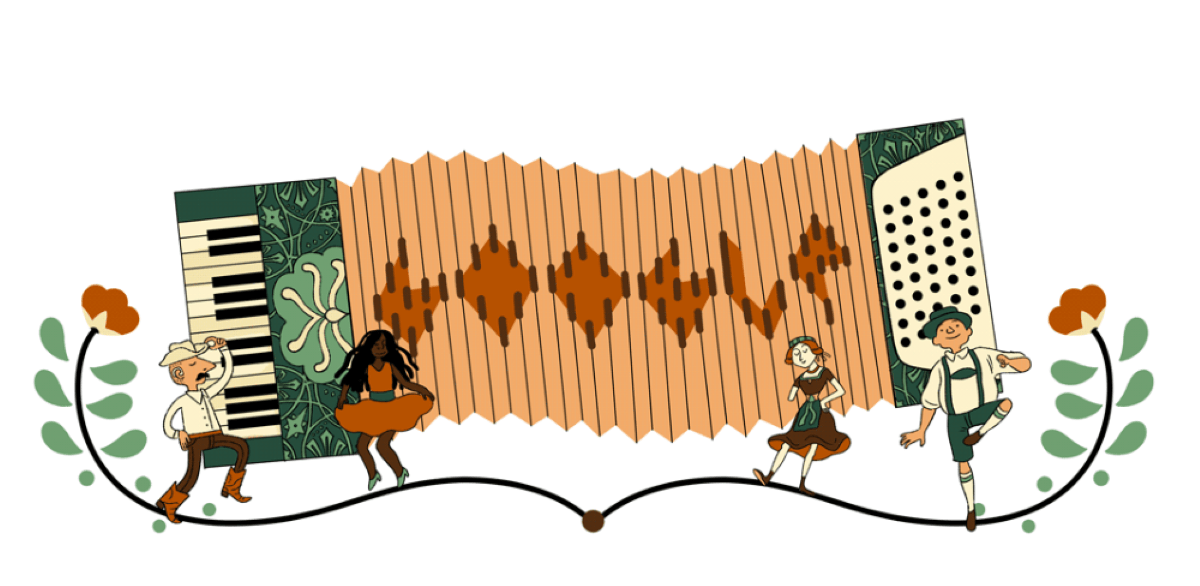Google Doodle: Today, Google is celebrating the anniversary of the accordion’s patent with a special doodle. This unique instrument was patented on this day in 1829 and has since become a staple in various music genres around the world.

Table of Contents
The Accordion’s Origin
- Name: Derived from the German word “akkord,” meaning chord.
- Inventor: The instrument was first patented in 1829, marking a significant milestone in music history.
A Versatile Musical Instrument
The animated Google Doodle highlights the accordion’s impact on music, showcasing its use in:
- Pop
- Jazz
- Folk
- Classical
Key Features of Early Accordions
According to the Google Doodle:
- Buttons: Early versions had buttons on one side that played entire chords.
- Bellows Mechanism: A single button could produce two different chords based on the bellows’ movement—one when expanding and another when contracting.
Historical Popularity Google Doodle
The accordion gained widespread popularity in the late 1800s, particularly among folk musicians in Europe. German manufacturers significantly ramped up production to meet the growing demand.
Celebrating the Accordion: A Versatile Musical Marvel
Today, Google’s animated Doodle celebrates the accordion, a free-reed instrument with bellows that has significantly impacted various music genres, including pop, jazz, folk, and classical.
The Evolution of the Accordion
- Early Beginnings: Patented in 1829, the accordion quickly captured the hearts of musicians and audiences alike. Its unique ability to produce a wide range of sounds made it a favorite across Europe.
- Technological Advancements: Initially, accordions had buttons on one side, each producing the sound of an entire chord. This innovative design allowed musicians to create rich, full-bodied music with relative ease.
Impact on Music Genres
The accordion’s adaptability has led to its integration into many music styles:
- Pop Music: Known for its lively and rhythmic contributions, the accordion has been featured in various pop songs, adding a distinctive and often festive element.
- Jazz: In jazz, the accordion brings a unique sound that complements the genre’s improvisational nature. Its ability to produce sustained tones and dynamic volume changes makes it a valuable asset.
- Folk Music: Perhaps most famously, the accordion is a staple in folk music traditions around the world. From European polkas to South American tangos, its sound is synonymous with cultural expression.
- Classical Music: Classical composers have also embraced the accordion, incorporating its rich tones into orchestral arrangements and solo performances.
Global Influence
The accordion’s journey from its invention in Germany to its global popularity is a testament to its versatility and charm. Manufacturers in Germany increased production in the late 1800s to meet the demand from folk musicians, spreading the instrument’s influence far and wide.
Notable Features
- Bellows: The bellows are the heart of the accordion, controlling the airflow and, consequently, the sound. This feature allows for expressive playing, with dynamics ranging from soft whispers to powerful crescendos.
- Reeds: Inside the accordion, reeds vibrate to produce sound when air flows over them. This mechanism is similar to that of harmonicas and organs, contributing to the accordion’s unique timbre.
- Buttons and Keys: Modern accordions come in various configurations, with buttons or piano-style keys on both sides. This allows for a wide range of musical possibilities, making it suitable for solo and ensemble performances.
Celebrating a Musical Icon
The Google Doodle honoring the accordion is a celebration of an instrument that has brought joy to countless people. Its distinctive sound continues to resonate in diverse musical genres, bridging cultures and generations. Whether in the hands of a street performer or a concert virtuoso, the accordion remains a symbol of musical creativity and cultural heritage.
Conclusion
Today’s Google Doodle is a fitting tribute to an instrument that has brought joy to many and influenced countless musicians worldwide. Whether you enjoy pop, jazz, folk, or classical music, the accordion’s versatile sound continues to resonate across genres.

